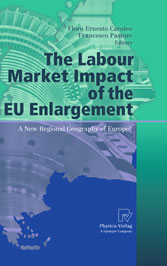Search and Find
Service
More of the content

The Labour Market Impact of the EU Enlargement - A New Regional Geography of Europe?
Acknowledgements
5
Contents
7
Contributors
9
Introduction
14
References
26
Part I An Overview of the Main Issues and the Role of Structural Change
27
Structural Change and Labour Reallocation Across Regions: A Review of the Literature
28
Introduction
29
Motivation
30
The Link Between Local Worker Reallocation and Unemployment
33
The Sources of Worker Reallocation
39
The Weakness of Backward Regions
44
Globalisation and Regional Imbalances
45
Adjustment Through Migration?
47
Poverty Trap Mechanisms
49
Policy Implications
50
Benefit Systems and Their Interaction with ALMP
50
EU Regional Policy
51
Concluding Remarks
52
References
53
Organized Labour and Restructuring: Coal Mines in the Czech Republic and Romania
59
Introduction
59
Restructuring Experiences of the Two Regions
61
Evaluating the Restructuring Paths
66
Measuring the Value of Labour inside Mines
67
Measuring the Value of Labour outside Mines
68
Measuring the Efficiency of Restructuring Paths
71
Explaining the Restructuring Paths
75
Gradual Restructuring with Transfer Payments
75
The Nature of the Miners´ Action
77
The Corroborating Factors for the Miners´ Action
80
Conclusion
81
References
81
Part II New Evidence on Spatial Convergence
83
Labour Productivity Polarization Across Western European Regions: Threshold Effects Versus Neighbourhood Effects
84
Introduction
84
Regional Productivity Differentials in Europe: Polarization and Spatial Clustering
87
Explaining Polarization
92
The Conditioning Scheme
92
Growth Regression Model Specifications
93
Regression Results
96
Conditioned Ergodic Distributions
99
Discussion and Conclusions
101
Appendix: List of regions
102
References
104
Transition, Regional Features, Growth and Labour Market Dynamics
107
Introduction
108
Transition, Regional Features and Economic Performance: A Partial Review of the Literature
109
Regional Labour Market Dynamics in Transition Economies
111
Economic and Structural Convergence of Regions in Europe and in the Transition Countries
112
Initial Conditions, Transition and Economic Performance: Some Stylized Facts
115
Initial Economic and Institutional Conditions
116
Institutional Change and Reform Policies
118
Economic Performance
119
Regional Features of Transition Countries: Some Empirical Results
124
Regional Convergence, Growth, Employment and Institutional Change: Econometric Investigations
131
Income Convergence of Regions
131
Value Added and Employment Growth in CEEC Regions
135
Conclusions and Policy Implications
139
Appendix
141
References
152
Regional Dynamics of Unemployment in Poland A Convergence Approach
156
Introduction
157
Literature Review
159
Methodology
161
Data
163
Results - Distribution Dynamics
165
Results - beta Convergence
173
Conclusions
177
References
179
Spatial Distribution of Key Macroeconomic Growth Indicators in the EU-27: A Theoretical and Empirical Investigation
181
Introduction
182
Long-Run Dynamics
183
Spatial Distribution of Basic Macroeconomic Variables
184
Estimating the Natural Rate of Unemployment
186
Estimating ``Pure Productivity´´
190
Concluding Remarks
193
Appendix1
194
Appendix2
195
Appendix3
196
Appendix4
197
References
200
Part III Is Migration Reinforcing Regional Unemployment Differences?
201
Internal Labour Mobility in Central Europe and the Baltic Region: Evidence from Labour Force Surveys
202
Introduction
203
Review of the Literature
204
Covariates of Labour Mobility
205
Data and Methodology
207
Definition of Mobility
208
Specification
209
Main Results
211
On the Determinants of Commuting
211
On the Determinants of Migration
216
Conclusions and Their Implications for Policy
226
Conclusions
226
Some Policy Implications
227
References
229
Spatial Search and Commuting with Asymmetric Changes of the Wage Distribution
231
Introduction
231
Reservation Wages
233
Search Intensities
235
Maximal Acceptable Travel Cost
235
Participation and Commuting
236
Data
237
Estimation
238
Conclusion
240
Appendix
241
Proof of Proposition 1
241
Proof of Proposition 2
244
Proof of Proposition 3
245
Negative Binomial Model
247
Zero-Inflated Models
247
Data Used
248
References
248
Where Do the Brainy Italians Go?
250
Introduction
250
The Italian Research System and Related Literature
252
The Italian System
252
Previous Related Research
254
Model, Variables, and Data
257
Model of Country Choice
257
Independent Variables and Hypotheses
258
Data
260
Results
263
Sample Characteristics
263
Multinomial Logit Results
266
Summary and Conclusion
270
References
273
Part IV Some Policy Tools
275
Assessing Active Labour Market Policies in Transition Economies
276
Introduction
277
Types of Active Labour Market Policies, Scope and Applicability
278
Macroeconometric Evaluation of ALMP Measures
283
The Microeconometric Evaluation Problem and ``First Generation´´ Papers on the Evaluation of ALMP in Transition Coun
288
Vodopivec (1999) on Slovenia
290
Some Second Generation Models and Their Contribution to the Literature
292
Micklewright and Nagy (2005) on Hungary
292
Rodriguez-Planas and Benus (2006) on Romania
294
Bonin and Rinne (2006) on Serbia and Montenegro
296
Van Ours (2004) on Slovakia
297
Kluve et al. (2008) on Poland
299
Implementing a ``Moving Window´´
299
The Matching Estimator
301
Empirical Results
304
Conclusions
306
References
307
Regional Female Labour Force Participation: An Empirical Application with Spatial Effects
309
Introduction
310
Empirical Model
314
Data and Descriptive Statistics
316
Empirical Results
318
Conclusions
323
References
325
About the Editors
327
Subject Index
335
All prices incl. VAT











